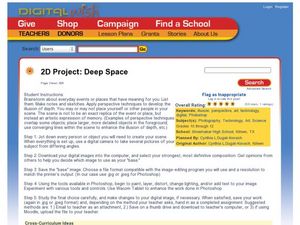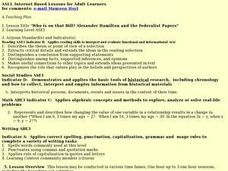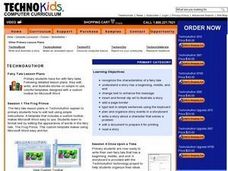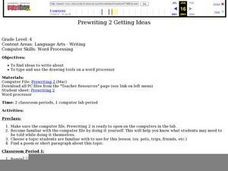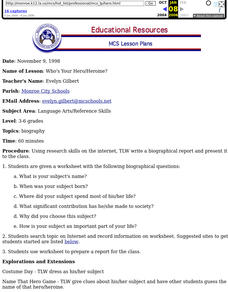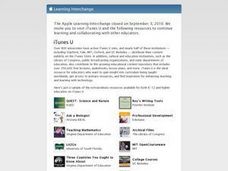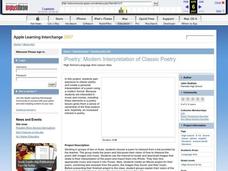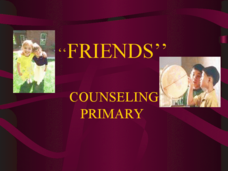Curated OER
Technology: Creating Introductions with Digital Cameras
Third graders discover how to use digital video cameras to record introductions of themselves for Powerpoint presentations. They decide what to say, which points to highlight, and how to interest viewers. Their Powerpoint presentations...
Curated OER
Graphing
Intended for a faith-based classroom, this lesson requires second graders to create a survey, conduct the survey in multiple classrooms, and graph the results. They can choose between creating a picture or bar graph, or you can require...
Digital Wish
2D Project: Deep Space
Using a digital camera, Photoshop, and a desktop paint program, learners will explore perspective techniques. They apply perspective techniques to develop depth illusions within a scene. The lesson employs both traditional art and...
Curated OER
Blogging to Create a Community of Writers
One of the keys for successful teaching is connecting curriculum to real-life experiences. This lesson on blogging does this, by making writing, revising, and publishing a reality. Pupils create a character for a story, write about their...
Curated OER
Publishing a Newspaper about Biomes
Young journalists create newspapers of individual biomes after researching their biomes. This instructional activity can be completed in three phases and concludes with each person publishing their individual newspaper pages.
Curated OER
Utilizing Vocabulary
You can use flip books as a means to practice and apply new vocabulary in any content area.
Curated OER
Who is on that Bill? Alexander Hamilton and the Federalist Papers
Students, who are adult learners, participate in an Internet scavenger hunt in order to assimilate information about the biography of Alexander Hamilton and the Federalist Papers. They look at the Federalist and Anti-Federalist Papers...
Curated OER
Math Prefixes
Students use a dictionary to gather appropriate information for writing simple definitions. They recognize prefixes that relate to numbers, such as mono-, bi-, and tri-. Pupils use their creative abilities to extrapolate new words to...
Curated OER
As the Kids Come and Go: Mapping a Classroom
Map the classroom with your kids to help them understand how maps work and how to read them. The lesson starts off with a story about animals living and moving around the globe, and then kids create maps of their classroom to show how...
Curated OER
Techno Author
Here is a great way to explore language arts by completing a computer activity with classmates. Youngsters read a fairy tale in class and analyze where the beginning, middle and end are. They create their own story using clip art and...
Curated OER
Check it Out...Nonfiction Can Be Fun!
Organizing information gathered for a research topic can be a challenge. Read aloud notes you have collected on a topic and use suggestions offer by the class to categorize and sort this information. Partners then follow this pattern,...
Harper Collins
If You Give...Series Teaching Guide
If you give teachers a few good ideas, they can really bring a story to life. Included in this resource are dozens of activities to use as your class reads books in the If You Give... series. From holding puppet shows and creating...
Curated OER
Using a Dictionary
When do we use dictionaries? Provide this dictionary scavenger hunt for your youngsters. Third and fourth graders search for words, recording the number of syllables or definition for a variety of words. Get your class using dictionaries...
Curated OER
Prewriting 2 Getting Ideas
Fourth graders read a poem or short paragraph and have students picture it in their minds. They relate the topic to something in their experience and illustrate, 4th graders generate questions with a graphic organizer, use Prewriting2...
Curated OER
Who's Your Hero/Heroine?
Young scholars use research skills on the Internet and write a biographical report and present it to the class. They utilize a worksheet that's imbedded in this plan to guide them in their research. students come to school dressed up as...
Curated OER
Comparing Mitosis with Meiosis
Life science learners view an online animated mini textbook comparing two types of cell division. Working in groups, they use a digital microscope to capture images of cells in different stages of mitosis and meiosis. Then they create an...
Curated OER
The Heart of the Matter
Upper elementary pupils learn about the blood transportation system and anatomy of the human heart. They fill in an outline of the human heart (not included) focusing on the flow of blood to and from the heart. Using stethoscopes,...
Curated OER
Reflections on the Self - Self Portrait
Students produce their own self-portraits and use them to create a book in iPhoto. They explore the visual symbols used by artists to communicate their feelings, interests, and identity.
Curated OER
iPoetry: Modern Interpretation of Classic Poetry
Young scholars interpret a piece of poetry with images and music in a movie project.
Curated OER
Friends
First graders use the software Inspiration to create a web describing characteristics of a good friend. With the use of a digital camera and PowerPoint, 1st graders create "Friends Found" posters after reading the book, "Don't Need...
Curated OER
Political Polls
Students explore politcical polling by conducting a poll of student body elections. They prepare a survey, distribute forms, and tabulate data.
Curated OER
Prepare to Read Nonfiction
Students explore the components of a KWL chart as they examine the facts of a story about the Leaning Tower of Pisa. Vocabulary from additional stories is utilized to form antonyms and synonyms.
Curated OER
Introduction to Victorian Valentines
Students explore the history of Valentine's Day and how paper valentines became a tradition in Victorian times. Using a photo organizer, they select photos using tags. They use a software program to create a special image for their...
Curated OER
Character Webbing- Romeo and Juliet
Students use technology to be engaged in an Language Arts assignment. The play of Romeo and Juliet is viewed on the computer and all skills related to its viewing are accomplished at the computer station.


